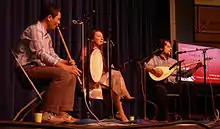Türkische Volksmusik
Die türkische Volksmusik (türkisch Türk Halk Müziği, abgekürzt THM) ist das älteste traditionelle Musikgenre der türkischen Musik (s. auch den Artikel Musik der Türkei#Volksmusik). Türkü ist die Bezeichnung für ein türkisches Volkslied.

Orchester
Tonleitern
In der türkischen Volksmusik werden verschiedene Tonleitern (ayak „Fuß, Stufe, Gangart“) benutzt, wie z. B.:
- Kerem Ayağı (a b c' d' e' f' g' a')
- Garip Ayağı (a b cis' d' e' fis' g/gis' a')
- Do Kararlı Müstezat (c d e f g a h c')
- Misket Ayağı (fis g a h cis' d' e' fis')
- Bozlak Ayağı (a b c' d' e' f' g' a')
- Derbeder (Kalenderi) Ayağı (a b c' des' e' f' g' a')
Musikinstrumente
Blasinstrumente
- Çığırtma, Flöte aus dem Knochen eines Adlerflügels mit sieben Fingerlöchern
- Çifte
- Kaval (mit oder ohne Zunge)
- Mey
- Sipsi
- Tulum
- Zurna
Saiteninstrumente
1. Zupfinstrumente
2. Streichinstrumente
Schlaginstrumente
Interpreten
s. den Artikel Liste türkischer Musiker#Traditionelle Musikrichtungen
Quellen
- Vasfi Çilingir: Müzik eğitimi. Ankara 1990.
This article is issued from Wikipedia. The text is licensed under Creative Commons - Attribution - Sharealike. The authors of the article are listed here. Additional terms may apply for the media files, click on images to show image meta data.